Professor Gerta Keller et al.* survey the state of mass extinction studies, over 30 years since Walter and Luis Alvarez, Frank Asaro and Helen Michel discovered the KT impact.
The nature and causes of mass extinctions in the geological past have remained topics of intense scientific debate for the past three decades. Central to this debate is the question of whether one, or several large bolide impacts, the eruption of large igneous provinces (LIPs), or a combination of the two were the primary mechanism(s) driving the environmental and habitat changes that are universally regarded as the proximate causes for four of the five major Phanerozoic extinction events.
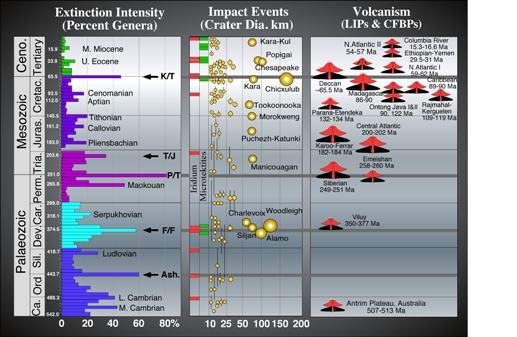 Mass extinctions, impacts and large igneous provinces during the Phanerozoic. Stratigraphic subdivisions and numerical ages from the 2004 International Stratigraphy Chart (ICS). Genera compilation from Sepkoski (l996), Hallam and Wignall (1997) and MacLeod (2003); impact database from Grieve (1997), LIPS and CFBP database from Courtillot and Renne (2003). Note that the Chicxulub impact predates the K-T boundary by 120,000 years, based on the time scale of Gradstein et al. (2004). (Modified after Keller, 2005)
Mass extinctions, impacts and large igneous provinces during the Phanerozoic. Stratigraphic subdivisions and numerical ages from the 2004 International Stratigraphy Chart (ICS). Genera compilation from Sepkoski (l996), Hallam and Wignall (1997) and MacLeod (2003); impact database from Grieve (1997), LIPS and CFBP database from Courtillot and Renne (2003). Note that the Chicxulub impact predates the K-T boundary by 120,000 years, based on the time scale of Gradstein et al. (2004). (Modified after Keller, 2005)
Recent years have seen a revolution in our understanding of both interplanetary environments and LIP eruptions and their environmental effects, so that a simple ‘impact-kill’ scenario no longer seems an adequate explanation for the end-Cretaceous mass extinction - or any other. Instead, combinations of massive sequential volcanic eruptions and the breakup of giant comets, leading to rapid climate change and environmental catastrophe, have emerged as the leading causes of such events.
MATURED
Considerable recent research efforts have focused on understanding the context and nature of the environmental changes that surrounded the five major mass extinctions. Significant new analytical data and observations have resulted - from fields as diverse as geochronology, geochemistry, palaeontology, sedimentology, stratigraphy, palaeomagnetism, volcanology and geophysics. The body of scientific evidence based on these new data has matured to a point that requires us to review hypotheses about the cause(s) of these eco-evolutionary events.
To this end, the Natural History Museum, London, will host an international conference on March 27-29 next year to bring together researchers from many disciplines to assess the current records on volcanism, impacts and mass extinctions, and the stratigraphic and geochemical records of environmental change across major mass extinction episodes.
The conference will try to assess the present status of the historic ‘gap’ between proponents of different mass extinctions cause scenarios and hypotheses, by integrating evidence from different disciplines. The intention will be to identify mutual interests and complimentary expertise, and so foster a new, collaborative, interdisciplinary community-wide approach to resolving the field’s outstanding problems. Data and concepts presented and discussed will have broad implications extending through and beyond the geoscience community, because they will summarise the type of important baseline data necessary for understanding ancient and modern species extinctions.
The two main culprits proposed in the early 1980s as potential causes for major mass extinctions are asteroid impacts and large volcanic eruptions. The most popular case remains that of the Cretaceous-Tertiary Paleogene (KPg or KT) mass extinction, which is associated with both an impact (Chicxulub, Yucatan) and flood basalt (Deccan Traps, India).
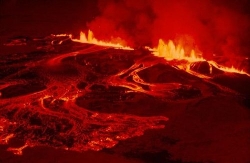 Laki volcanic eruptions (Iceland) of 1783 lasted nearly a year, extruded about 15km3 of lava and caused major famine and climate changes over several years. Such eruptions are an example in miniature of just one of a series of gigantic Deccan flows that amounted to 667 Laki eruptions.
Laki volcanic eruptions (Iceland) of 1783 lasted nearly a year, extruded about 15km3 of lava and caused major famine and climate changes over several years. Such eruptions are an example in miniature of just one of a series of gigantic Deccan flows that amounted to 667 Laki eruptions.
VOLCANISM
Deccan volcanic flows probably occurred as "pulses", some flows being truly gigantic with calculated original volumes >10,000 km3 and erupted in < 100 years (possibly only a decade). For comparison, the largest historical basaltic eruption (1783, Laki, Iceland) erupted some 15 km3 of lava in about a year. So a single huge Deccan flow could have amounted to at least 667 ‘Lakis’ in less than 100 years! The vast amount of carbon and sulphur dioxides injected in the atmosphere from just one of these massive eruptions would have been on the same order of magnitude as those estimated to have been ejected by the Yucatan asteroid impact.
Debates over the proximate mechanisms of the KT extinction continue, but they are likely linked to these enormous pulsed injections of gases into the atmosphere, generating alternating episodes of cooling and warming, acid rain (leading to a marine calcification crisis), increased weathering and terrestrial runoff (leading to large nutrient influx into oceans and causing oxygen-depleted oceanic conditions hostile to marine life). In the case of the KT extinction, the impact would have exacerbated an already heavily stressed environment, due to Deccan volcanism, injecting gases in the same amounts and time scales as the individual huge, short volcanic pulses.
Using palaeontology, paleomagnetism and high-precision dating, we now know that the Deccan Trap eruptions occurred in three phases, with the main phase-2 near the end of the Cretaceous being closely associated with the KT mass extinction, and occurring within the same timeframe as the Chicxulub impact.
IMPACTS
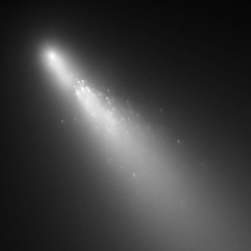 A 2006 Hubble telescope image of Comet P/73 Schwassmann-Wachmann, a small Jupiter family comet which began to disintegrate in 1995. A Chiron-sized object in this situation, which might have 1 to 10 million times the mass, would constitute a dangerous and prolonged terrestrial hazard.
A 2006 Hubble telescope image of Comet P/73 Schwassmann-Wachmann, a small Jupiter family comet which began to disintegrate in 1995. A Chiron-sized object in this situation, which might have 1 to 10 million times the mass, would constitute a dangerous and prolonged terrestrial hazard.
That the mass extinction of species at the KT boundary was caused by the impact of a 10km asteroid has been a mainstay of both popular journalism and much professional literature since the discovery of a thin layer of iridium at the KT boundary in 1980. As understood at that time, the main reservoir for impactors was the asteroid belt, with a small contribution from comets.
Recent years have seen a revolution in our understanding of the interplanetary environment and this simple picture is no longer adequate. Asteroids of 10km diameter straying from the main asteroid belt are exceedingly rare. At the level of mass extinction, the 10km solitary asteroid is the least likely of several possible impact scenarios. In contrast, large populations of comets have been discovered, held in deep freeze on the fringes of the planetary system. Many are large, such as 250km diameter Chiron, which may enter an Earth-crossing orbit strongly influenced by Jupiter within 0.2 million years.
A Chiron-sized comet may have a mass equivalent to 10,000-15,000 Chixculub-sized impactors, and its progressive Jupiter-influenced disintegration would yield a highly enhanced impact hazard at all scales with a prodigious dust influx into the stratosphere for the duration of its breakup. The duration of this enhanced hazard is difficult to predict, and could be anywhere from a few thousand to a few hundred thousand years.
In that situation, the terrestrial impact rate will increase by a factor several hundred during the half million years or so of the breakup, with an expectation of, say, a 10km body impact somewhere along the route accompanied by many smaller ones - as evidenced by the terrestrial record. Fireball storms over the duration of the breakup are liable to destroy stratospheric ozone and intermittently reduce incident sunlight. Such events, as much as impacts, may mean major biological trauma.
MASS EXTINCTIONS
Evidence from paleontology, sedimentology, geochemistry and geochronology reveals that none of the ‘big five’ mass extinctions was brought about by a single, instantaneous event causing sudden environmental collapse. All are characterized by prolonged periods of high stress before and after mass extinctions and three (end-Permian, end-Devonian, end-Ordovician) show multiple extinction phases, sometimes separated by hundreds of thousands of years. Extinction patterns are varied, sometimes affecting marine life more than terrestrial, but they are invariably selective and predominantly target shelly creatures that depend on the secretion of calcium carbonate. Despite these common patterns, no single cause has emerged, suggesting that multiple causes may produce the same catastrophic environmental effects.
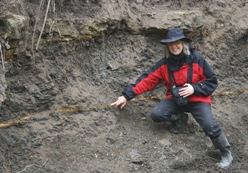 KT outcrop at the Brazos River, Texas shows two (yellow-green) impact spherule layers in bedded claystones of latest Maastrichtian age nearly 2m below the KT mass extinction. Gerta Keller for scale.
KT outcrop at the Brazos River, Texas shows two (yellow-green) impact spherule layers in bedded claystones of latest Maastrichtian age nearly 2m below the KT mass extinction. Gerta Keller for scale.
The KT mass extinction is primarily known for the demise of the dinosaurs, the Chicxulub impact as the presumed sole cause - and a rancorous 30 year-old controversy. However, among the five major mass extinctions, only the KT shows close correspondence between the mass extinction, an iridium anomaly, a large impact crater (Chicxulub) plus one small crater (Boltysh), one of the largest continental flood basalt eruptions (Deccan Traps) and major climate and sea level changes. Given the revolution in understanding of these events over the past decade a simple impact-kill scenario now seems inadequate.
The KT mass extinction affected primarily non-avian dinosaurs and marine organisms with calcareous shells. Many groups died out gradually or decreased in diversity and abundance well before the boundary, including dinosaurs, ammonites, inoceramids, rudists and planktic foraminifera. Only the latter, and to some extent nannofossils, show major, apparently sudden species extinctions coincident with the KT boundary and Ir anomaly, but even in this group a gradual decline in abundance and diversity of specialised species began with the rapid climate warming about 150,000 years before the KT B boundary, followed by cooling.
A recent study of planktic foraminifera in sediments between the massive Deccan lava flows of phase-2 documents their extinction in the lead-up up to the KT mass extinction. Accumulated evidence based on Chicxulub impact spherules throughout the Caribbean Central and North America also suggests that this impact may predate the mass extinction. This meeting will explore the links between the mass extinction, Deccan volcanism and the Chicxulub impact.
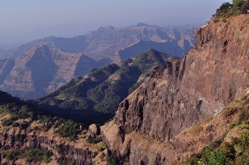 Deccan Traps in India show layered lava flows forming high (3000m) mountains and covering an area the size of France. Their original extent was about three times the size of France.
Deccan Traps in India show layered lava flows forming high (3000m) mountains and covering an area the size of France. Their original extent was about three times the size of France.
TRIASSIC-JURASSIC
The TJ mass extinction affected both the marine and terrestrial ecosystems severely and synchronously, coinciding with global greenhouse warming and major perturbations in the carbon cycle. It snuffed out the conodonts, nearly extinguished ammonoids, and led to the disappearance of reef communities for millions of years. Dinosaurs were the winners, benefiting from the ecologic opportunity granted by the high extinction rate of the dominant crurotarsan reptiles.
The cause for these environmental and biotic calamities has long been puzzling. Recently, a viable scenario emerged with U-Pb dating of the Central Atlantic Magmatic Province (CAMP) at ~200 Ma, synchronous with the TJ boundary. CAMP is now widely thought to have triggered the cascade of linked biotic and environmental catastrophes in Earth system, including the observed extreme global warming and cooling.
Many scientists hold extreme global warming to have been directly responsible for the mass extinction, whereas others argue that short pulses of cooling, induced by volcanically derived sulphate aerosols, may have been equally detrimental to the ecosystem. Although kill-mechanisms and details of the chain of events continue to be debated, new data linking CAMP volcanism to environmental and biotic change at the T-J boundary is now well-founded on multiple lines of stratigraphic, geochronologic, geochemical and paleontological evidence. These need to be reviewed and integrated into one or more predictive models that can be tested against existing observations.
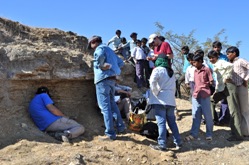 Fieldwork in India investigating intertrappean sediments for clues to the rate and nature of the KT mass extinction. Curious locals try to be helpful.
Fieldwork in India investigating intertrappean sediments for clues to the rate and nature of the KT mass extinction. Curious locals try to be helpful.
PERMIAN-TRIASSIC
This mass extinction event (252Ma) marks the most severe crisis of the fossil record, culminating in a spectacular coup de grâce at the end of the Permian. In the oceans, extinction losses were devastating - and remarkably unselective - while on land, extinctions were equally catastrophic -plant communities suffering the worst crisis in Earth history.
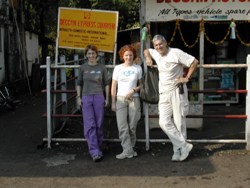 Deccan field team: Ann Jay, Anne-Lise Chenet, Vincent Courtillot
Deccan field team: Ann Jay, Anne-Lise Chenet, Vincent Courtillot
Attempts at linking this mass extinction to a meteorite strike have been unsuccessful. The Siberian Traps, a vast area of flood basalts that erupted at precisely the time of the crisis, appear to be the most likely cause. However, it is one thing to highlight a coincidence and another to link these two very different phenomena. The killing mechanism could have been the combined effect of sulphur dioxide (causing short-term cooling) and the longer-term global warming effect of carbon dioxide. Both gases were released from Siberian Trap eruptions, in addition to those released from coal and evaporites baked by the lava. However, it is still unclear how these emissions caused environmental damage sufficiently severe to trigger a catastrophe of such scale.
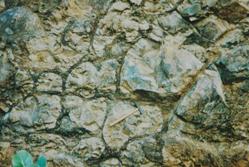 Pillow lavas from Curaçao, part of the late Cretaceous Caribbean Oceanic Plateau, which has been implicated as the cause of oceanic anoxia and environmental crisis at The Cenomanian-Turonian boundary.
Pillow lavas from Curaçao, part of the late Cretaceous Caribbean Oceanic Plateau, which has been implicated as the cause of oceanic anoxia and environmental crisis at The Cenomanian-Turonian boundary.
END FRASNIAN
The Late Devonian mass extinction (Frasnian-Famennian (FF) (376.1 ± 3.6 Ma) occurred over several million years with a series of extinction pulses in the latest Frasnian. Most severely affected were major reef builders (corals and stromatoporoids) causing the near-disappearance of reefs, along with decimation of marine invertebrates. Terrestrial environments were relatively little affected.
Impacts, volcanism, oceanographic and climatic changes have all been proposed, and continue to be debated, as causes for this mass extinction. The 65-75km Siljan Ring crater (Sweden ~377 Ma) has been proposed as one cause, although it is relatively small and no evidence exists for multiple impacts that might explain the series of extinction pulses. Another potential cause are the Viluy Traps in Eastern Siberia; but preliminary dating suggests a younger age (370Ma).
Changes in the oceanographic and climatic systems are relatively well documented for this critical interval. Most prominent are the black shale facies that developed in the world’s ocean during the latest Frasnian, denoting anoxic to euxinic conditions. These probably resulted from higher primary productivity triggered by increased nutrient input from enhanced weathering. A goal of our meeting will be to integrate current data into one or more predictive models that can be tested against existing observations. Current knowledge suggests that recurrent eutrophication, anoxia, perturbation of the global carbon cycle and climate change may all have contributed to the end-Devonian mass extinction.
END ORDOVICIAN
The end-Ordovician saw a rapid rise in extinction (in two pulses) concomitant with a rise in originations. The extinction removed few entire clades but caused minimal disruption to marine ecosystems. The first pulse targeted benthic organisms in deep and shallow-water environments as well as graptolites and nektic groups. Suggested killing mechanisms include glacially induced cooling, falling sea level and reduction of habitable shelf-space and chemical recycling in the oceans.
The second extinction pulse is associated with a strong sea-level rise and ocean anoxia, marking a brief warm event. Extinctions were less selective, wiping out faunas across a range of depths and killing off, mainly, the survivors of the first extinction pulse. To date there is no impact or volcanic evidence associated with these extinctions. Although there is no consensus about how climate change directly influenced global biodiversity, in the absence of volcanism or impacts at the end of the Ordovician, a few alternatives present themselves. Another goal of this meeting is to explore causal mechanisms of mass extinctions other than volcanism and impact.
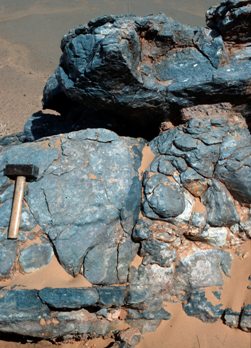 Late Frasnian black carbonates (Kellwasser facies - Antiatlas/Morocco) indicating oxygen-poor conditions in shelf waters during the FF crisis.
Late Frasnian black carbonates (Kellwasser facies - Antiatlas/Morocco) indicating oxygen-poor conditions in shelf waters during the FF crisis.
SMALLER EVENTS
Although the ‘big-five’ extinction events have received most research attention, realisation is growing that smaller (‘second order’) extinction events have also played a significant role in shaping life on our planet. Over the last 200 million years such second-order (predominantly marine) extinction events (e.g., Tithonian, Aptian-Albian, and Cenomanian-Turonian) are invariably associated with the global deposition of black shales - signifying widespread oceanic anoxia and severe environmental perturbation. These periods are all marked by the eruption of vast oceanic plateaus (oceanic LIPs), and a causal link between these voluminous undersea eruptions and the associated extinction events/environmental crises is now accepted by many researchers.
Among the ‘kill-mechanisms’ are: the release of carbon dioxide and associated warming; trace metal poisoning; nutrient upwelling due to disturbed circulation, and oceanic acidification from sulphur dioxide release. The meeting will explore these biotic stresses that may lead to mass extinctions.
CONCLUSION
Current data suggest that the leading causes of mass extinction events are either massive (LIP) volcanism (four out of the big five), or impacts - particularly the breakup of large comets. Should the two coincide, as during the KT mass extinction, this would almost certainly cause a mass extinction as one would exacerbate the other. Some or all of these effects are observed or speculated to have occurred during all five mass extinctions. However, at least one (end-Ordovician) cannot be associated with either impacts or volcanism.
We intend, at this conference, to bring together many disciplines and proponents of all the different scenarios, to assess and integrate the current records of volcanism, impacts and mass extinctions, as well as the stratigraphic and geochemical record of environmental change across major mass extinction events. We trust that it will identify mutual interests and complimentary expertise and above all foster a new, collaborative interdisciplinary and community-wide approach to resolving the outstanding problems in this field.
For more information and references, readers are referred to Geoscientist online, where a longer version of this feature is also available. For registration details visit www.massextinction.princeton.edu.html for information and www.minersoc.org/mass-extinctions.html for registration.
Authors
Gerta Keller1, Howard Armstrong2, Vincent Courtillot3, David Harper2, Michael Joachimski4, Andrew Kerr5, Norman MacLeod6, William Napier7, József Palfy8, Paul Wignall9
1: Department of Geosciences, Princeton University, Princeton NJ 08540, USA; 2: Department of Earth Sciences, Durham University, South Road, Durham DH1 3LE, UK; 3: Equipe de Paléomagnétisme, Institut de Physique du Globe, UMR 7154, et Science de la Terre de l’Environment et des Planètes, Université Paris Diderot, Sorbonne Paris, France; 4: GeoZentrum Nordbayern, University of Erlangen-Nuremberg, 91054 Erlangen, Germany; 5: School of Earth and Ocean Sciences, Cardiff University, Cardiff, Wales, UK CF10 3AT; 6: Earth Sciences Department, The Natural History Museum, Cromwell Road, London, SW7 5BD; 7: Buckingham Centre for Astrobiology, University of Buckingham, Buckingham MK18 1EG UK; 8: Dept. of Physical and Applied Geology, Eötvös University, Budapest, H-1117 Hungary; 9: School of Earth and Environment, University of Leeds, LS2 9JT, UK.